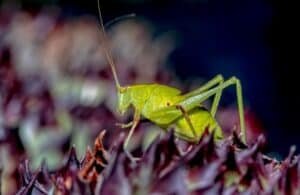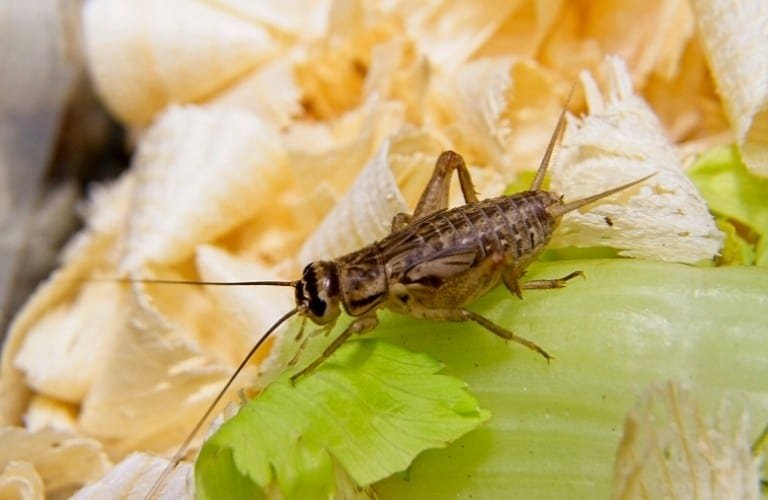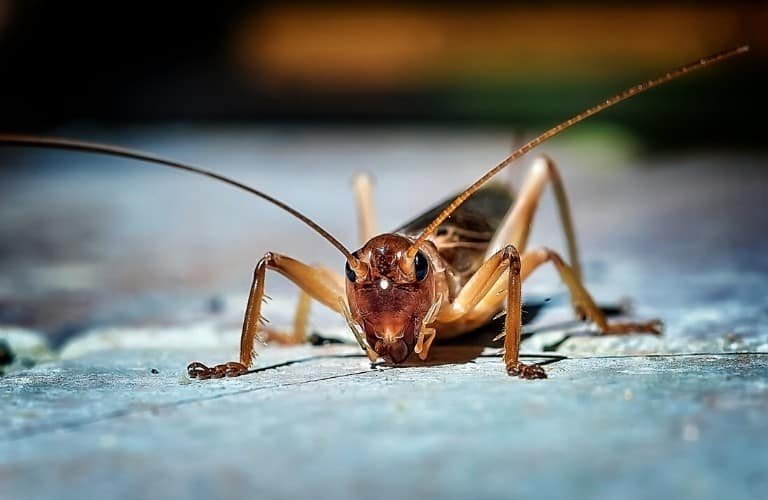Crickets are creepy to some and annoying for most. They can chirp outside your window all night long or make their way inside and begin to ruin your clothing and carpets.
Luckily there are some easy ways you can repel them.
What is the best cricket repellent? Natural methods, like keeping the yard clean and dry; encouraging natural predators; using DIY sprays made from essential oils, garlic, or chili powder; and installing LED lights, will repel crickets. Purchased sprays and pesticides will repel them also.
Let’s take a look at the different types of repellent there are and how you can utilize them in or around your home.
You can find lots more cricket info, prevention tips, and elimination guidelines on our cricket page here.
Best Practices for Preventing an Infestation
Before you can prevent crickets, you should know exactly what you’re looking for.
The Cricket
Crickets are usually black or various shades of brown, but they can also be green.
They have six legs, and the back pair is the largest and allows the crickets to jump long distances. They have wings, although most species can’t fly.
The wings do, however, help fend off predators and help them make large jumps.
Cricket names can be confusing as some species are known by several different common names. We explain in this article.
Crickets might also be mistaken for katydids (bush crickets) or grasshoppers.
Katydids are usually about 2 1/2 inches long, and their legs line up with their bodies.
Katydid
Grasshoppers are usually found in the grass during the day, grow to be about 3 inches, and have short antennae.
Grasshopper
Crickets, however, only get up to about 2 inches long, their legs don’t line up with their bodies, and they have long antennae.
You may have heard that you can tell the difference between these three by their color, but that’s not true.
All three insects can be black, brown, or green. Below is a photo that shows the cricket’s body type, short wings, and long antennae.
Basic Guidelines
Crickets love rotting food and damp spaces. (Learn what crickets eat here.)
This combination is usually what draws them to your yard and inside your home.
Prevention is simple: remove their desired habitats.
Be sure to check with our complete guide, “How To Get Rid of Crickets,” for additional tips and elimination techniques.
Tidy Your Yard
If you have long grass, overgrown shrubs and trees, and piles of leaves, you’re basically asking for crickets to stay for a while.
The humidity in these overgrown areas provides the perfect environment for crickets to live and mate.
(You can use this to your advantage by placing DIY traps in and around these areas before cleaning them up.)
Routine yard maintenance will keep the crickets away:
- Mow the grass.
- Trim bushes and tree limbs.
- Do not keep compost piles close to the house.
- Remove debris (including furniture you’re not using).
- Keep firewood in a stacked pile away from your house.
Lower the Humidity
You can’t change the weather, but you can reduce moisture levels around your home.
- Clean the gutters to remove moisture.
- Don’t let water stay pooled in flowerbeds and on sidewalks.
- Don’t leave containers out to collect water.
- Water plants early in the morning so moisture can evaporate before the evening.
Seal Your Home
Crickets get inside your home through cracks and crevices. If you see any openings, seal them up.
Look for areas that might be leaking. Cracks around windows and doors are prime places for them to enter.
If you have an attic that holds a lot of moisture, make sure there aren’t tree limbs touching the roof.
Crickets frequently hang out in trees and can find their way into your attic by hopping off the tree.
Cricket Repellent – What to Look For
Many cricket repellents can be made at home or left to nature (birds and snakes eat them and cats like to hunt them).
However, there are also some handy products you can buy and apply inside or outside your home.
Types of Cricket Repellent
- DIY sprays: You can mix essential oils, garlic cloves, or chili powder with water and spray it around your home. Essential oils might ruin some surfaces; otherwise, these types of solutions are perfectly safe inside the home unless someone has an allergy.
- LED lights: Crickets are attracted to light – unless it comes from an LED bulb. Replacing your porch light with an LED light or installing several solar-powered LED lights around your yard won’t attract them.
- Natural bug repellent: If you don’t want to make your own spray, you can buy some that use natural ingredients that are safe to use inside.
- Insecticide bait: This will kill crickets in the area and will also repel them.
What Smells Do Crickets Hate?
Crickets hate the scents of garlic, onion, beans, and other nitrogen-fixing plants. You can use these plants to repel them from your yard and patio by planting them in the area.
Many nitrogen-fixing plants are perfect for container gardening, so you can easily slip them into areas where you often find crickets, like by a door or garage.
Crickets also hate the scent of clove oil, peppermint oil, and chili powder. You can use these ingredients inside your home to drive them away.
Effectiveness
The effectiveness of each type of repellent will vary based on several factors, and sometimes it’s not quite clear why one particular method does or doesn’t work.
Many people swear by essential oils and use that as their only repellent against crickets, but they may not work for others.
This could be because the spray wasn’t potent enough or it wasn’t sprayed in the right areas.
When you apply a spray, whether it was DIY or purchased, make sure you spray the areas you see crickets the most and around potential entry points.
If you have no idea where they’re coming from, you can spray the perimeter of your house.
If you don’t think a repellent is working as well as it could be, try using another repellent with it.
Doubling up methods will increase the potency and be more effective at keeping crickets away.
Safe for Use Around People and Pets
Most natural remedies are safe to use around people and pets. The only issues with DIY options are potential allergies and skin irritants.
Chili powder will burn the eyes, and essential oils will irritate the skin if they aren’t diluted enough.
If you or someone in your home is allergic to an ingredient, the advantages of the remedy will be negated.
Repellents with chemicals, like insecticide bait, are not safe.
Children and pets should be removed from the area while applying any chemical, and you should wear protective gear to make sure it doesn’t touch your skin or get in your eyes or nose.
Carefully read the label so you can follow the instructions and safety guidelines it provides.
Ease of Use
Most repellents are simple to use. There are disposable and reusable options for both indoor and outdoor use.
Reusable
LED lights won’t last forever, but they do last much longer than regular light bulbs. With proper usage, an LED bulb can last for almost three years.
They don’t burn out like regular bulbs, but they’ll get dim over time. Because of their long life span, they can be considered reusable.
Repellent sprays eventually run out, but you can buy the ingredients in bulk to make a continual supply.
Disposable
Sticky traps and pesticides are disposable. They can last for quite a long time indoors and outdoors, but keep in mind that rain will wash away pesticides and dust storms will ruin sticky traps.
Best Indoor Cricket Repellents
Let’s take a look at some of the best cricket repellent options. Some of these will work outdoors as well.
Essential Oils
Essential oils are derived from plants, and luckily for humans, crickets and a plethora of other insects hate them.
Crickets hate the oils that come from rosemary, thyme, sage, and cloves.
Eugenol is derived from cloves and appears to be the most effective. It’s used for toothaches, so it can be a bit expensive.
A cheaper alternative is SVA Organics Ojas Shield Blend, which contains essential oils from clove, rosemary, and a few other plants.
Add 10-15 drops of oil into a spray bottle of water and mix it up. Spray where needed, but make sure your furniture and other surfaces won’t stain.
Pros:
- A natural option that comes straight from the plants.
- Lasts a long time since you only need a few drops.
- Repels more than just crickets.
Cons:
- May stain some surfaces.
- Irritates skin if not properly diluted.
Cinoton LED Wall Light Pack
LED lights repel crickets because crickets don’t like the type of light they emit.
We recommend this 2-pack because they’re waterproof and can easily be installed on almost any wall.
They’re automated and turn on once the sun goes down and turn off at sunrise. You can replace your porch light with one or use it in addition to your porch light.
If you want to use an LED bulb in an existing light fixture, LOHAS Dusk to Dawn Sensor Light Bulb should fit in most fixtures and also turn on automatically when it’s dark.
Pros:
- Won’t bring crickets to your door.
- Waterproof.
- Long lifespan of about five years.
Cons:
- Might not be able to work on every wall.
Garlic
Head to your pantry and grab a few cloves of garlic. Peel and crush them and place them in a spray bottle of water. Allow it to steep for a couple of days.
Shake it up before you spray, and then apply it to areas where you see crickets. They hate the smell and will leave the area.
If you don’t have spray bottles at home, these amber glass spray bottles are a good option because they’re glass, which means they’re easy to clean and won’t absorb garlic odor.
Pros:
- Inexpensive solution.
- Easy to make again and again.
- Repels other insects.
Cons:
- Will make the room smell like garlic.
Chili Powder
Chili powder is another ingredient you can use in a DIY repellent. It’s easy to make because you just have to put the powder in water, and it doesn’t involve steeping.
This one is a bit more hazardous than the garlic spray because chili powder can burn the eyes and nose.
Curious pets and small children should be kept away from the area if you choose to use this. It’s highly effective, so it’s definitely worth the try.
Pros:
- Highly effective because it’s spicy.
- Doesn’t require much power for a single batch.
- No steeping necessary.
Cons:
- Will irritate the eyes and nose.
Mighty Mint Spider Repellent
If you’d rather purchase a premade spray, Mighty Mint is a great option.
Although it’s sold as a spider repellent, it’s made with peppermint oil that’s effective against many insects, including crickets.
Many use this product specifically for crickets because it’s so effective.
The peppermint scent is likely more preferable than garlic or chili, so it’ll be a more enjoyable product to use in the home.
Pros:
- Peppermint scent is enjoyable enough to use indoors.
- Safe for people and pets.
- Can be sprayed almost everywhere.
Cons:
- Peppermint scent might be overwhelming for some.
Best Outdoor Cricket Repellent
It’s easier to keep crickets out of your house if you start repelling them outside since that’s where they prefer to live. Let’s look at some of those options.
EcoSMART Home Pest Control
This natural spray can either be used indoors in cracks and crevices or outside along the perimeter of your home.
It uses peppermint oil and clove oil to repel crickets and other insects, but it can also kill on contact if you spray it directly on the bug.
Although it’s meant to be used outside, it can still wash away with water, so you’ll need to reapply it after it rains.
Pros:
- Made with natural ingredients.
- Safe for people, pets, and the environment.
- Kills crickets if you spray it on them.
Cons:
- Will wash away with water.
Nitrogen-Fixing Plants
Crickets don’t like the smell of plants that produce a lot of nitrogen. This includes sweet potatoes, peas, garlic, beans, clover, cilantro, and legumes.
If you can plant these around your home or on window sills, they’ll deter the crickets, and you’ll also get the benefit of harvesting your own food.
If you don’t have space to grow things on your patio and porch or don’t have much of a green thumb, the Futone Grow Bags are a good option.
They’re portable and have a Velcro flap that allows you to easily harvest foods like potatoes and garlic.
Pros:
- Repels crickets.
- Gives you food to eat.
- Several plants repel crickets, so you can pick your favorite.
Cons:
- Water can go through the material.
Encourage Natural Predators
This may seem counteractive when you’re trying to get rid of crickets, but nature can do a pretty good job of getting rid of them.
Adventurous cats like to hunt them and birds like to eat them. Snakes, frogs, and toads also eat them.
You can encourage the enjoyable predators like birds with Nature’s Hangout Store Window Bird Feeder.
This feeder hooks onto windows with suction cups. Place birdseed in it, and then you can watch the birds.
You can place this on a window or door that frequently has crickets around it. Insect eating birds will spot crickets and eat them as they hang around the feeder.
Pros:
- Animals will control the population for you.
- Attract interesting animals like birds so you can watch.
- No chemicals or DIY required.
Cons:
- Requires you to allow animals around your home.
- Rats and mice eat crickets.
Catchmaster Cricket XL Cricket Trap
This is a trap instead of a repellent, but it will help lower the cricket population when you really need it.
Place this on your patio, deck, or somewhere else near your door and window where you frequently find crickets.
They’ll be attracted to this trap, land on it, and won’t be able to get away.
Use this product with caution. It should only be placed in protected areas because the cricket design may attract birds, which can get stuck on the trap and die.
Try placing them underneath things such as grills or patio furniture so the design can’t be seen.
Pros:
- Traps crickets as soon as they land.
- Crickets can’t escape.
- Quick way to kill several in a short period of time.
Cons:
- Potentially harmful to other animals.
- Won’t work if it gets wet or collects dust.
Niban Granular Insecticide Bait
Granular bait kills crickets when they walk on it or eat it. It also acts as a repellent, so the cricket population will dwindle since it’s a pesticide repellent.
It also kills and repels several types of ants, roaches, silverfish, and other pests.
This is a pesticide that contains harmful chemicals. It could harm the environment and will harm people and pets if it’s ingested.
The granules will stick around for a few weeks, so be sure to monitor children and pets after you apply it. Read the label carefully if you choose to use this method.
Pros:
- Kills and repels crickets.
- Effective against several insects and pests.
- Will stick around even after it rains.
Cons:
- Contains harmful chemicals.
- Not safe for the environment.
Final Thoughts
Crickets are fiends to many people. They aren’t harmful, although they can bite and give you flu-like symptoms (learn which crickets to be wary of here).
Fortunately for us, they aren’t good at biting so it won’t happen often. Try to repel them outdoors first so they can’t make their way inside.
It’s best to use natural options over ones that have chemicals, especially if you have children or pets who frequently go outside.
Source:
https://retrofitcompanies.com/myths-about-led-lighting-and-led-light-bulbs/
















